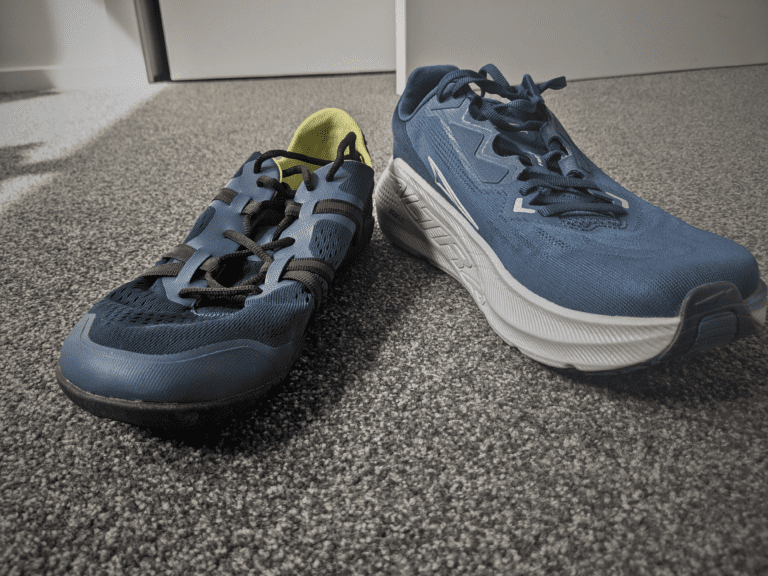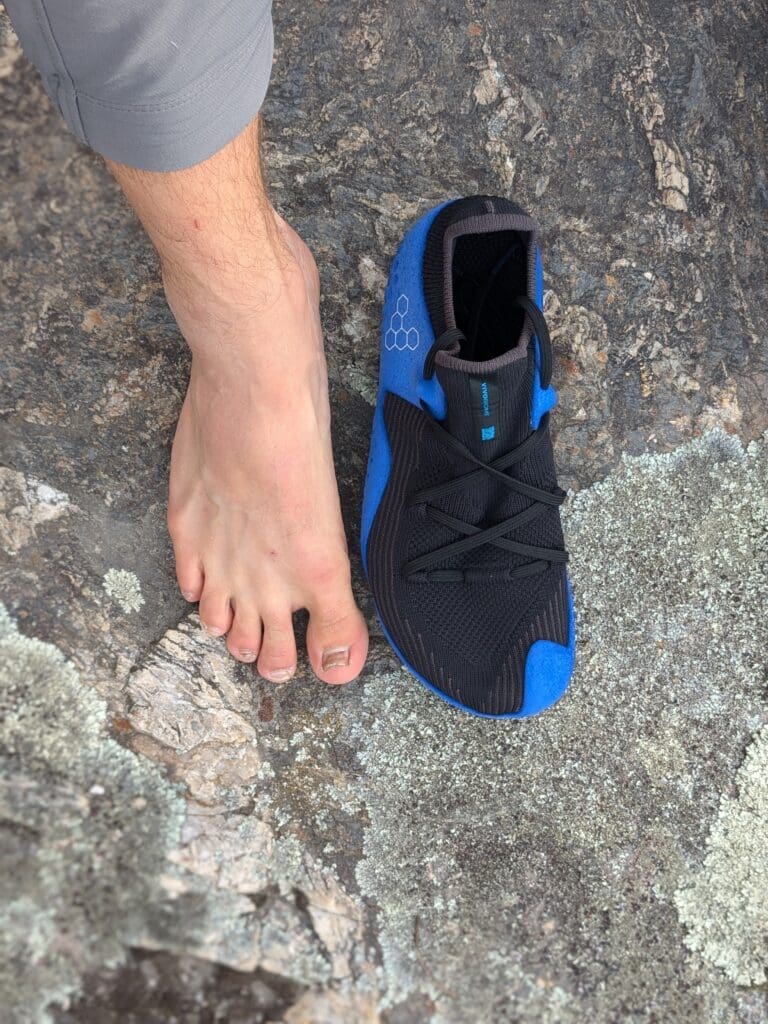Most runners have heard of zero-drop shoes, but many have yet to try them out for fear of injuries, pre-established brand alliances, or a lack of options on the market.
But what if I were to flip the script and question:
Why do shoes have a ‘drop’ at all? Why do shoe manufacturers raise the heel higher than the forefoot?
It’s a puzzling question, isn’t it? I’m sure many of us can’t come up with a logical reason for this, yet it’s the norm in the mass market. This begs the question: Is the traditional running shoe design the most beneficial for us? Or are zero drop shoes the way forward?
I can think of some reasons you’d want to run in zero drop shoes. They…
- Allow for an even weight distribution between your forefoot and heel without compromising posture
- Provide the best opportunity to achieve an unhindered running gait
- Help you avoid excessive heel striking (controversial in some circles)
But let’s dive deeper into the “whys” behind zero drop.
Before we look at the why, it’s worth understanding exactly what zero drop is.
If you’re already 100% confident with the answer, feel free to scroll past this section!
In simple terms, zero drop is:
> When your heel is at the same level as your forefoot.
Now, this can mean 30mm above the ground, i.e., a high stack shoe, or 4mm above the ground, i.e., a minimal shoe. But either way, your foot must be level.
Zero drop has been around for a long time.
Simple moccasins and foot wraps would have historically been zero drop, and even old Converse and Vans are zero drop (they do squish the toes, though, so not a great option).
But zero-drop shoes aren’t widespread in the running world. In fact, we’re in a shoe manufacturing cycle that produces anything but zero-drop shoes!
However, you may have heard of the running shoe brand Altra, which is traditionally a zero drop brand. One of the founders, Golden, is also credited with coining the name zero drop. However, it should be noted that Altra now offers a small line of 4mm drop shoes.
In the minimal/barefoot market, we see far more companies adopting the zero drop philosophy. Almost all brands making barefoot shoes ensure they make models that are zero drop to match ‘being barefoot’ as closely as possible. Remember, if you’re standing barefoot, your foot is completely flat or flush against the floor = zero drop.
So why would you want to opt for zero drop shoes?
This one is easier to explain through a practical example.
- Take your shoes off
- Go find a thick book and place it on the floor
- Now position your heels on the book and your forefoot on the ground
- Now, step off the book so your heels and forefoot are on the ground
- Step on and off like this a few times and feel how your weight shifts
When you have your heels on the book, you should feel your hips shift forward. You may also feel a slight tilt in the spine too.
Your body naturally shifts into this position to ensure your center of mass is balanced over your feet.
This is your body adapting to the external factors, which is great in the short term.
But in the long term, this elongation could put excessive stress on many different joints up and down the body.
And this is where shoes with a higher drop could pose an issue.
Our bodies can indeed adapt to these conditions, but without a valid reason to adapt to higher-drop shoes, it’s only logical that we should avoid shoes with an elevated heel.
Which Altra Shoe is for you?
Take a quick 4-question quiz to identify the perfect Altra running shoe for your feet! You'll get both road and trail options based on your answers!
Claiming that zero drop shoes can promote a better running gait is controversial because the literature has not determined what a “better running gait” is.
My interpretation comes in by paying attention to my body, which checks out (and aligns with many others’ viewpoints, too).
Go and run barefoot
Head outside, remove your socks and shoes and run 10-20 meters.
- Notice how you land.
- Notice what part of the foot contacts the ground first.
- Notice the length of your stride.
Hopefully, you found that:
- You land softly
- Your mid or forefoot hits the ground first
- Your stride is short
This tells me the body is set up to avoid overstriding and slamming the heel into the ground. It also tells me I want to use the foot’s muscular structure to land as softly as possible to reduce impact forces.
However, just because we believe the body is “designed” to run barefoot doesn’t mean that barefoot is the most optimal. With the lack of evidence to show that a different way of running or different shoe options reduces injuries, I’m happy to conclude that we should move towards a stride that is “as barefoot” as possible.
In fact, if speed is your goal, we can argue the exact opposite—i.e., higher, more cushioned shoes would allow you to easily lengthen your stride, allowing you to move faster with a longer stride at the same cadence!
But speed can be saved for race day. Keeping fit and healthy should be the goal during training.
Zero Drop strengthens the calves and lower legs
When you go out on your first zero drop run, you’ll no doubt notice that your calves ache the day after.
In a zero drop shoe, you heavily rely on your calves, among other lower leg muscles, to provide stability and propulsion.
Again, this is more similar to being barefoot, where your lower leg muscles will activate upon absorbing the impact of your footfall and propulsion to push you off again.
The exact opposite is true when you run in shoes with a drop. Your Achilles and calves will be in a shortened position, and your foot will slightly point down towards the ground. Upon impact, this awkward position hinders the lower leg, foot, and ankle, reducing the ability to slow the impact and lessening the load on tendons and muscles for propulsion at the end of the stride.
As long as you approach zero drop carefully and slowly, your calves and lower legs will build strength over time, leading to more stability and even better performance later on.
The key here is “slowly and carefully”—especially when transitioning from conventional shoes that have very likely led to the weakening of such muscles in the first place.
Hopefully, I’ve convinced you that utilizing zero drop shoes in your running rotation could benefit you.
I’m not saying you have to give up your old pair of shoes if you still like them, but you should at least consider rotating them in and out.
In the end, after training in zero-drop shoes for a while, I’m fairly certain you’ll find it hard to return to your ‘high-heeled’ running shoes. But I’ll leave that judgment up to you!




Every morning when I wake up, I ask myself two questions; why is the cost of living so damn high, and why is there still drop in shoes even if we’re not cowboy riders anymore. Lol.
Haha! Tell me about it. I’d love to hear logical reasons why use a drop, rather than the question being, “is zero drop safe”. I understand drop as an intervention for injury, but that doesn’t account for 99% out there.
So Zero drop is actually Zero raise…raising the heel from barefoot, always found the drop bit to be weird. Good article by the way & glad you are spreading the word on natural foot shape :o)
BTW Have you tried Freet ? (Not associated but trying the odd shoe especially with grippy trail outsoles)
That’s a good way of putting it!
> Have you tried Freet?
I haven’t yet sadly. I tried to make some connections when I was back home (the company is very close to where I grew up), but sadly I wasn’t able to get any replies. 🙁